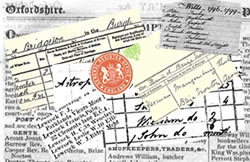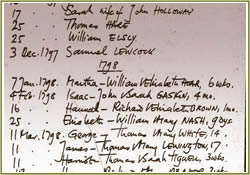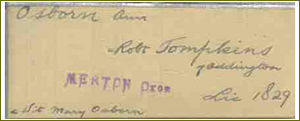Difference between revisions of "Records Office Guide"
Darksecretz (talk | contribs) |
Darksecretz (talk | contribs) |
||
| Line 110: | Line 110: | ||
'''1837''' Age & abode together with Father's name & occupation added to Marriages. | '''1837''' Age & abode together with Father's name & occupation added to Marriages. | ||
<br><br><br> | <br><br><br> | ||
| + | |||
| + | |||
| + | |||
| + | |||
| + | |||
| + | |||
==Census Returns== | ==Census Returns== | ||
| − | + | '''What will I find?''' | |
<div align="right">[[Image:TUDSBURY1901-3.jpg|250px|thumb|Images of extracts subject to crown copyright]]</div> | <div align="right">[[Image:TUDSBURY1901-3.jpg|250px|thumb|Images of extracts subject to crown copyright]]</div> | ||
| Line 163: | Line 169: | ||
<br><br> | <br><br> | ||
| − | + | '''How are they useful ?''' | |
When evaluating census information it is worth remembering that they are merely a snapshot record made every ten years. Ancestors may be missing due to war or may simply have been in transit on census night and lodged somewhere. There is an element of innacuracy that researchers need to factor in to their findings and they should be used with other sources of evidence to gain a fuller picture. Particular details on these records may give clues as to personal wealth and social standing e.g. when an entry declares living by own means. If you can follow the record of one person alone through the decades you can sometimes see how a person's life or career has developed e.g. at 16 a person is a groom, at 26 is a clerk, at 36 has a family, at 46 has a factory, at 56 has servants and so on. | When evaluating census information it is worth remembering that they are merely a snapshot record made every ten years. Ancestors may be missing due to war or may simply have been in transit on census night and lodged somewhere. There is an element of innacuracy that researchers need to factor in to their findings and they should be used with other sources of evidence to gain a fuller picture. Particular details on these records may give clues as to personal wealth and social standing e.g. when an entry declares living by own means. If you can follow the record of one person alone through the decades you can sometimes see how a person's life or career has developed e.g. at 16 a person is a groom, at 26 is a clerk, at 36 has a family, at 46 has a factory, at 56 has servants and so on. | ||
Revision as of 18:11, 31 March 2007
Contents
A Guide To Information Available In Your Local Records Office
The biggest headache in locating record offices is boundary changes. Records that relate to your area often end up archived in their original shire county despite the introduction of unitary authorities and metropolitan boroughs and counties.
To view the set up of Counties Prior to the changes implemented in 1974, click here
Births Marriages and Deaths
The system of civil registration of births, marriages and deaths in England and Wales was established on July 1st 1837. The country was divided into registration districts based on poor law unions. Today the system is based on the areas of local authorities. Each registration district is under the control of Superintendent Registrars and divided into sub-districts. Copies of registers are sent to the Registrar General and the indexes are compiled.
The indexes are divided into quarters for each year up to 1983. Remember that the index relates to the time of registration NOT the time of the event. Since 1984 events have been arranged in alphabetical indexes covering a full year. Exact place of birth is not given, just the name of the Registration District with a different reference numbering system.
The Office for National Statistics (ONS) Indexes and copies have been distributed nationwide. Some can be viewed in local libraries, County Records Offices or even Local Archive and History Study Centres. You will not be charged for viewing these images. These images are available online but the odd sheet is missing.
Burial Records
How do I find them?
Registers are held in many different locations and there is no comprehensive index to them. Before the 1850s the vast majority of burials were recorded in the parish registers of the Church of England, although some nonconformist chapels had their own burial grounds. After that, the situation becomes much more complex, with the beginning of private and civic cemeteries.
If the death took place before the mid-1850s, you should start by looking in the relevant parish burial registers. Most Church of England registers are deposited in county record offices, although later ones may still be held at the church. An Act of Parliament in 1853 enabled local authorities to purchase and use land for the purpose of burial. So although many burials continued to take place in local parish churchyards (particularly in rural areas) the situation in large towns and cities became much more complicated. You will need to consult maps of the area to find out which cemeteries and churchyards were situated closest to the person’s home address.
Cemetery and crematorium records are generally held and maintained by local authorities. Their addresses can usually be found on the relevant local authority’s website, and in local phone books. Contact details for over 1000 burial grounds and crematoria can also be found at The Bereavement Services Portal.
What do they contain?
Unfortunately, different burial registers during different periods of time differ in their format and the amount of information they contain.
In early parish registers we encounter a simple written statement such as “John son of John Cowl and Mary his wife, was buried 10 January 1782. In later parish registers, we find a pre-printed page with columns of information, including entry number, “Name”, “Abode”, “When Buried”, “Age”, and a final column “By whom the ceremony was performed”. In addition, it is not uncommon for the vicar to add other notes.
Essentially, the later registers contain the most information, and so these must be the ones on which our “standard” is based.
Sometimes, earlier registers have more information, and even the later ones have additional information written in the margins on occasion.
Generally you could expect to find the following:
- No (The register entry number) Pre-printed in later style registers, none in early registers.
- Burial Date Format: dd mon yyyy/y e.g. 17 May 1804 or 17 May 1804/5
- First name This is simply the Christian name of the person.
- Relationship This is quite often found as: “wife of George”, “son of John & Elizabeth” etc. In most earlier burial registers this information is stated, although it may not be noted in later registers when the pre-printed forms are used.
- Surname This is the Family Surname.
- Age The age at death. The following examples of abbreviations are used:
- 16 years ( a whole number used alone)
- 1y3m years & months
- 2y8m6d years, months & days
- 2m 2 months
- 1w 1 week
- 5d 5 days
- 7h 7 hours
- Abode In later registers, and sometimes earlier ones too, the town, or even full address of the family are entered. Sometimes addresses may be quite long, e.g. “ 8 Waddington View, Bakewell, Nottinghamshire” especially where the address is not in the same parish as the baptism.
Parish Registers
Parish registers were started in England in 1538. A law was passed ordering the clergy to record baptisms, marriages and burials, and that they should be written down in a book after the service on Sundays, and in the presence of the Churchwardens. Before this date there were no records, except for a few created by monks who recorded the events for prominent families. Many churches, however, did not begin keeping records until a further notice was sent out in 1558, and even then, many did not comply.
In 1597, Queen Elizabeth I decreed that all existing records should be copied into "fair parchment books, at least from the beginning of this reign". There was considerable opposition. Many churches complained that they could not afford parchment books, others began the task, some started with the 1558 records, some omitted large sections as the task was too large, and some did not start at all.
Some of the early 1538 records (re-written in 1597) still exist, but it is not at all unusual for the registers not to have been preserved. Many were lost, and it is quite common to find no preserved records for a parish until a much later date.
Most of the parish registers are now stored in a County Record Office, although a few are still in the individual churches.
Over time, more information was recorded in the parish registers.
1538 Basic information for Baptisms, Marriages and Burials
1754 Witnesses & Signatures added to Marriages
1813 Father's occupation and abode added to Baptisms and Abode & age added (sometimes occupation) to Burials.
1837 Age & abode together with Father's name & occupation added to Marriages.
Census Returns
What will I find?
On each census you should find recorded: Address, name, relationship to the head of the family, marital status, age at last birthday, gender, occupation, birthplace, disability.
Some censi only make reference to a household number rather than a formal numbered address.
The 1841 Census did not declare relationship to head of household and was lacking in the detail of later censi.
Ages of adults over the age of 15 were rounded up or down to the nearest 5 years.
For example, a man and wife aged 52 and 48 would both be recorded as aged 50.
Ages of children below 15 were far more accurate.
You may find that with institutions, small villages and hamlets, residents or inmates are recorded using just intials, age and/or a birthplace (if known) or otherwise just initials.
Each entry on a census is given a four part reference: class (RG or HO) + piece + folio + page number, which is a unique reference given to a particular page. Everyone recorded on one particular sheet will have this same code. The lower example to the right is recorded as RG13/3194/50/2. The image shows the class and piece reference found at the foot of the sheet.
Census dates in the Victorian Era
- 1901 ref always start RG13 - census date 31st March
- 1891 ref always start RG12 - census date 5th April
- 1881 ref always start RG11 - census date 3rd April
- 1871 ref always start RG10 - census date 2nd april
- 1861 ref always start RG9 - census date 7th April
- 1851 ref always start HO - census date 30th March
- 1841 ref always start HO - census date 7th June
Census records are usually transcribed for online viewing in this format:
- Name
- Parent or spouse names
- Birth Year
- Birthplace
- Relation (not 1841),
- Civil parish,
- County or Island (1841 census terms as born in county or out of county - OOC)
How are they useful ?
When evaluating census information it is worth remembering that they are merely a snapshot record made every ten years. Ancestors may be missing due to war or may simply have been in transit on census night and lodged somewhere. There is an element of innacuracy that researchers need to factor in to their findings and they should be used with other sources of evidence to gain a fuller picture. Particular details on these records may give clues as to personal wealth and social standing e.g. when an entry declares living by own means. If you can follow the record of one person alone through the decades you can sometimes see how a person's life or career has developed e.g. at 16 a person is a groom, at 26 is a clerk, at 36 has a family, at 46 has a factory, at 56 has servants and so on.
Census records provide a useful framework in that they allow us to track the progress of a family over a long period of time. Sudden ommissions may point towards other searches such as death records, census entries in army barracks or institutions and maritime records. Conversely, a known death or marriage between census years enables us to switch our attention to other family names. Modern websites such as Ancestry have made census access more convenient but there are mistranscriptions aplenty which should also be borne in mind. See Census Search for alternative tips on how to use the search facilities on that site.
Other Types of Records
- Archive Collections Needs text
- Architectural drawings and building plans Needs text
- Coroner’s Records MORE TXT ADDED NEEDS PROOF READING
- Court Sessions and Victuallers' Licences Needs text
- Directories: Trade, Street and City Proof read. Still needs more text
- Electoral Registers and Poll Books
- Emigration and Immigration Needs text
- Hospital Records
- Manorial, Land and Estate Deeds Needs text
- Maps: Tithe and Ordnance Survey Proof read. Needs visuals
- Military Records
- Newspapers and Journals Newspaper bit proof read. Info on Journals needs to be added
- Photographs Needs text
- Poor Law and Workhouse Records OC working on this one
- Records of Merchant Seamen
- School Records
- Taxation Records
- Wills and Probate Images added - waiting for final check of text by Pheonix








